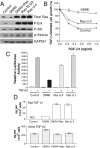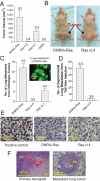Attenuation of TGF-β signaling suppresses premature senescence in a p21-dependent manner and promotes oncogenic Ras-mediated metastatic transformation in human mammary epithelial cells
- PMID: 22357622
- PMCID: PMC3327327
- DOI: 10.1091/mbc.E11-10-0849
Attenuation of TGF-β signaling suppresses premature senescence in a p21-dependent manner and promotes oncogenic Ras-mediated metastatic transformation in human mammary epithelial cells
Abstract
The molecular mechanisms that drive triple-negative, basal-like breast cancer progression are elusive. Few molecular targets have been identified for the prevention or treatment of this disease. Here we developed a series of isogenic basal-like human mammary epithelial cells (HMECs) with altered transforming growth factor-β (TGF-β) sensitivity and different malignancy, resembling a full spectrum of basal-like breast carcinogenesis, and determined the molecular mechanisms that contribute to oncogene-induced transformation of basal-like HMECs when TGF-β signaling is attenuated. We found that expression of a dominant-negative type II receptor (DNRII) of TGF-β abrogated autocrine TGF-β signaling in telomerase-immortalized HMECs and suppressed H-Ras-V12-induced senescence-like growth arrest (SLGA). Furthermore, coexpression of DNRII and H-Ras-V12 rendered HMECs highly tumorigenic and metastatic in vivo in comparison with H-Ras-V12-transformed HMECs that spontaneously escaped H-Ras-V12-induced SLGA. Microarray analysis revealed that p21 was the major player mediating Ras-induced SLGA, and attenuated or loss of p21 expression contributed to the escape from SLGA when autocrine TGF-β signaling was blocked in HMECs. Furthermore, knockdown of p21 also suppressed H-Ras-V12-induced SLGA. Our results identify that autocrine TGF-β signaling is an integral part of the cellular anti-transformation network by suppressing the expression of a host of genes, including p21-regulated genes, that mediate oncogene-induced transformation in basal-like breast cancer.
Figures







Similar articles
-
Estrogen receptor alpha inhibits senescence-like phenotype and facilitates transformation induced by oncogenic ras in human mammary epithelial cells.Oncotarget. 2016 Jun 28;7(26):39097-39107. doi: 10.18632/oncotarget.9772. Oncotarget. 2016. PMID: 27259243 Free PMC article.
-
TDAG51 is an ERK signaling target that opposes ERK-mediated HME16C mammary epithelial cell transformation.BMC Cancer. 2008 Jul 2;8:189. doi: 10.1186/1471-2407-8-189. BMC Cancer. 2008. PMID: 18597688 Free PMC article.
-
TGF-beta signaling engages an ATM-CHK2-p53-independent RAS-induced senescence and prevents malignant transformation in human mammary epithelial cells.Proc Natl Acad Sci U S A. 2011 May 24;108(21):8668-73. doi: 10.1073/pnas.1015022108. Epub 2011 May 9. Proc Natl Acad Sci U S A. 2011. PMID: 21555587 Free PMC article.
-
Noncanonical TGF-β signaling during mammary tumorigenesis.J Mammary Gland Biol Neoplasia. 2011 Jun;16(2):127-46. doi: 10.1007/s10911-011-9207-3. Epub 2011 Mar 31. J Mammary Gland Biol Neoplasia. 2011. PMID: 21448580 Free PMC article. Review.
-
Mammary epithelial cell transformation: insights from cell culture and mouse models.Breast Cancer Res. 2005;7(4):171-9. doi: 10.1186/bcr1275. Epub 2005 Jun 3. Breast Cancer Res. 2005. PMID: 15987472 Free PMC article. Review.
Cited by
-
FGF-2 induces a failure of cell cycle progression in cells harboring amplified K-Ras, revealing new insights into oncogene-induced senescence.Mol Omics. 2021 Oct 11;17(5):725-739. doi: 10.1039/d1mo00019e. Mol Omics. 2021. PMID: 34636387 Free PMC article.
-
Transforming Growth Factor-Beta and Oxidative Stress Interplay: Implications in Tumorigenesis and Cancer Progression.Oxid Med Cell Longev. 2015;2015:654594. doi: 10.1155/2015/654594. Epub 2015 May 20. Oxid Med Cell Longev. 2015. PMID: 26078812 Free PMC article. Review.
-
Conserved genes and pathways in primary human fibroblast strains undergoing replicative and radiation induced senescence.Biol Res. 2016 Jul 28;49(1):34. doi: 10.1186/s40659-016-0095-2. Biol Res. 2016. PMID: 27464526 Free PMC article.
-
TGF-β-Dependent Growth Arrest and Cell Migration in Benign and Malignant Breast Epithelial Cells Are Antagonistically Controlled by Rac1 and Rac1b.Int J Mol Sci. 2017 Jul 20;18(7):1574. doi: 10.3390/ijms18071574. Int J Mol Sci. 2017. PMID: 28726720 Free PMC article.
-
Long-Term In Vitro Expansion of Epithelial Stem Cells Enabled by Pharmacological Inhibition of PAK1-ROCK-Myosin II and TGF-β Signaling.Cell Rep. 2018 Oct 16;25(3):598-610.e5. doi: 10.1016/j.celrep.2018.09.072. Cell Rep. 2018. PMID: 30332641 Free PMC article.
References
-
- Adorno M, et al. A mutant-p53/Smad complex opposes p63 to empower TGFbeta-induced metastasis. Cell. 2009;137:87–98. - PubMed
-
- Bandyopadhyay A, Zhu Y, Cibull ML, Bao L, Chen C, Sun L. A soluble transforming growth factor beta type III receptor suppresses tumorigenicity and metastasis of human breast cancer MDA-MB-231 cells. Cancer Res. 1999;59:5041–5046. - PubMed
-
- Bartkova J, et al. DNA damage response as a candidate anti-cancer barrier in early human tumorigenesis. Nature. 2005;434:864–870. - PubMed
-
- Bierie B, Moses HL. TGF-beta and cancer. Cytokine Growth Factor Rev. 2006;17:29–40. - PubMed
-
- Bild AH, et al. Oncogenic pathway signatures in human cancers as a guide to targeted therapies. Nature. 2006;439:353–357. - PubMed
Publication types
MeSH terms
Substances
Grants and funding
LinkOut - more resources
Full Text Sources
Medical

